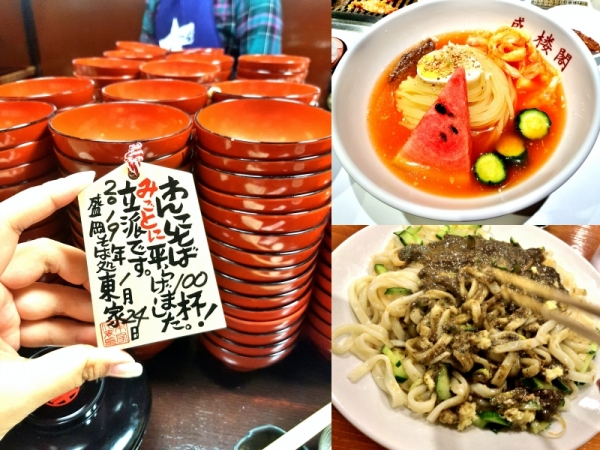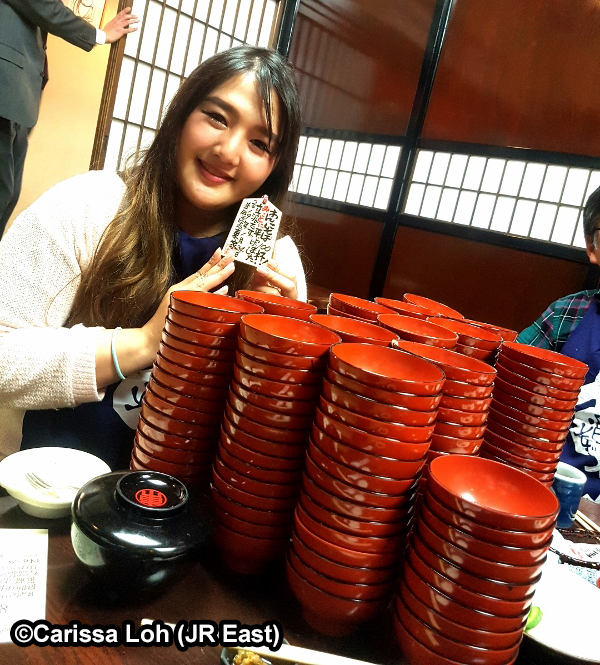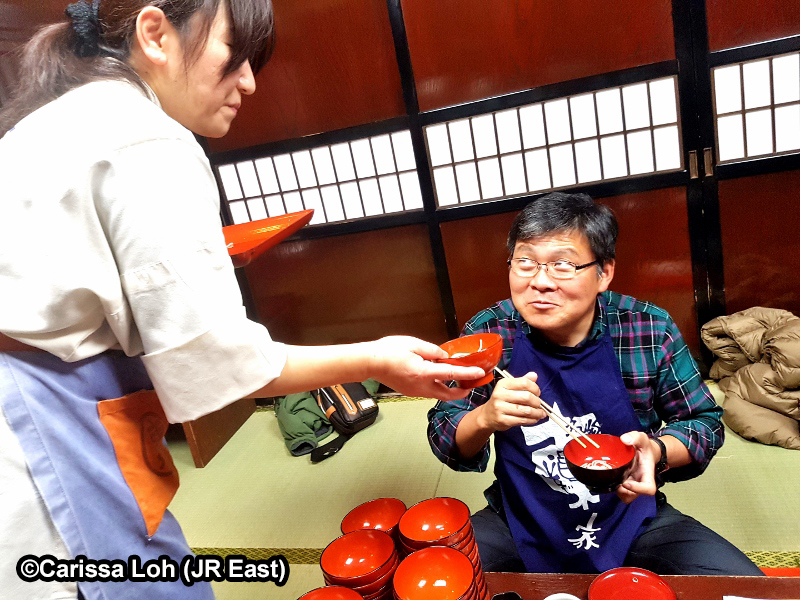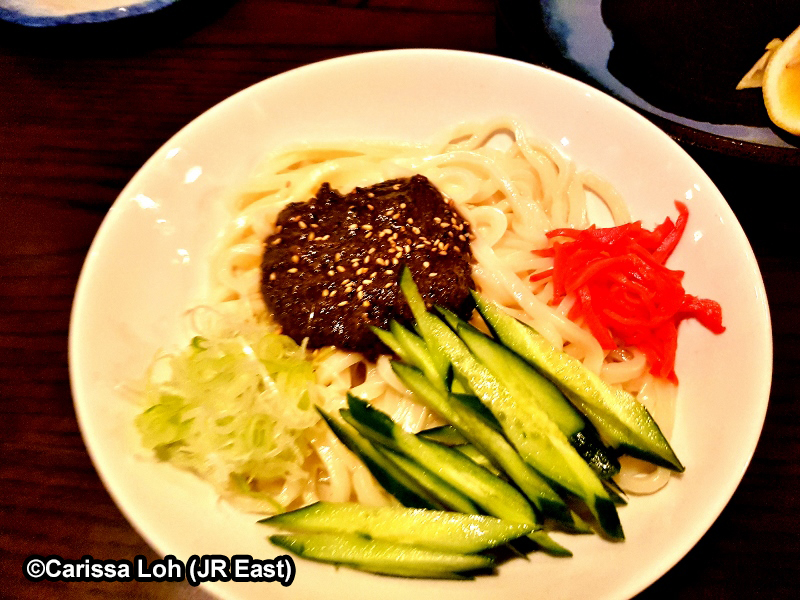Oodles of noodles: Morioka’s 3 Great Noodles

They say you never really know a place until you’ve tried its food. Well, a visit to Morioka City (盛岡市) in Iwate Prefecture (岩手県) is not complete without trying its Three Great Noodles (三大麺 sandaimen): wanko soba, reimen and jajamen. Only 2.5 hours by bullet train from Tokyo, Morioka is a convenient city to base yourself for exploring the northern Tohoku Region. While you are there, take the chance to try all of the noodles – one every day (or every meal if you’re game for it).
Wanko Soba (わんこそば)
First up, let’s dive right into the most challenging to stomach: wanko soba. Wanko soba is not just soba, it is an experience and a challenge. Wanko soba is an eat-until-you-drop challenge not for the faint of heart!

A group trying out the wanko soba challenge. (Image credit: 岩手県観光協会)
Soba noodles are served in bite-sized portions, and you try to eat as much as you can, without stopping. Once you finish your portion, it is instantly refilled by the zealous servers standing behind you with a dozen more bowls on hand. When you decide to stop (by placing the lid on your bowl) the challenge is over. Just saying "No more!" won't stop the eager staff from refilling your bowl! Other than soba, seasoning like spring onions, ginger and wasabi, and side dishes like pickled vegetables and sashimi are provided for a change in palate.

Finished 100 bowls! (Image credit: JR East / Carissa Loh)
I must confess, I am not crazy about soba. I much prefer thicker, chewier noodles like udon. So for this challenge, I was planning to stop at 60+. However, the very motivational waitress kept cheering me on: "Go for 70, lucky 7!", "Just a bit more to 77, double 7!", "Almost 80, do it!”, “88, nice number!”, "Try to hit 90 for an even 6 stacks!" (One stack is 15 bowls). "Just a few more till 100!" And so...I miraculously made it to 100! But even now I still can't eat soba without gagging.

Attempting the wanko soba challenge. How many do you think he ate? Answer in next photo. (Image credit: JR East / Carissa Loh)
15 portions = 1 regular bowl of soba. The record is a staggering 570 bowls, held by a lady from Morioka! The average man can eat about 80, while the average woman about 60.

Being encouraged by the servers, he ended up making it to 111 bowls. (Image credit: JR East / Carissa Loh)
If you feel like giving up, the encouraging servers cheer you on. Depending on the staff on duty, you will get cheers like "Only 60? How disappointing! You can do better than that! I’ll be keeping an eye on you!", or "Ganbatte! Aim for 90, you're almost there! You can do it!"

Certificates for completing the wanko soba challenge! (Image credit: JR East / Carissa Loh)
Once you are done with the challenge, you will receive a paper certificate with your name, date of visit, and number of bowls completed. Hit 100 bowls and you’ll get a special wooden certificate.
For wanko soba restaurants, I recommend Azumaya (東家), they have many stores around Morioka, and have an English menu to cater to foreign visitors. They also provide foreign diners with a mini guidebook in English, explaining the history of and how to eat wanko soba. The restaurant can also cater to Muslim visitors by preparing a Muslim-friendly version of their wanko soba which contains no alcohol or meat. (Advanced reservations are required for Muslim-friendly wanko soba.)

Special katsudon set at Azumaya. (Image credit: JR East / Go Takahashi)
If you are not keen on downing dozens of bowls of soba, or are just accompanying your friends who are doing the challenge, don’t worry about going hungry. Other than wanko soba, the restaurant also serves local Iwate cuisine, donburi (丼ぶり rice dishes) and regular soba dishes.
Azumaya (Ekimae Branch) (東家駅前店)
Address: 8-11 Morioka-Ekimae-dori, Morioka-shi, Iwate 020-0034
Access: In front of JR Morioka Station
Tel: +81-19-622-2233
Azumaya Honten (Main Branch) (東家本店)
Address: 1-8-3 Nakanohashi-dori, Morioka-shi, Iwate 020-0871
Access: From JR Morioka Station, take a local bus Morioka Bus Center, then walk for 3 minutes.
Tel: +81-120-733-130
Reimen (冷麺)
Next up, my favourite of the three: reimen! This is something I can eat a couple of times a week.

A delicious bowl of reimen. (Image credit: JR East / Carissa Loh)
A Korean-inspired dish, reimen literally means "cold noodles". It is a delightful dish featuring cold, translucent noodles in a slightly spicy beef broth, and is often served with a slice of watermelon or pear. Other toppings include half a hard-boiled egg, sliced cucumbers, kimchi and a slice of meat. Some restaurants even let you choose the level of spiciness. However, keep in mind that Japanese "spicy" is not as spicy as Southeast Asia, so keep your expectations in check. ”. Outside of Morioka, it is known around Japan as “Morioka Reimen”.

Reimen is best paired with BBQ. (Image credit: JR East / Carissa Loh)
Pair reimen with barbeque or grilled meat for a scrumptious dinner! Seirokaku (盛楼閣) is a well-known reimen and barbeque restaurant just across the street from JR Morioka Station. It can get pretty packed in the evenings and on weekends, so either make a reservation in advance or be prepared to wait.
Seirokaku (盛楼閣)
Address: 2F GEN Plaza, 15-5 Morioka Ekimae-dori, Morioka, Iwate
Access: From JR Morioka Station, walk 2 minutes.
Business hours: 11:00–02:00
Tel: +81-19-654-8752
Jajamen (じゃじゃ麺)
Taking its roots from the Chinese zhájiàngmiàn (炸酱面), which also inspired the Korean jjajangmyeon (짜장면), jajamen is Japan’s take on the black bean noodle dish, adapted to suit the locals’ palates.

Jajamen. (Image credit: JR East / Carissa Loh)
Jajamen contains minced meat and miso, and the thick white noodles are similar to udon. It is often garnished with sliced cucumbers, spring onions and a side of red ginger. If you are a fan of dry noodles as opposed to soupy noodles, you might prefer this over the other two. Once you are ready to eat it, mix the noodles, sauce and vegetables, add seasonings like garlic, chilli oil and vinegar to your taste, and then eat up.

Mixed jajamen (left) and chitantan (right). (Image credits: JR East / Go Takahashi)
But don’t down the whole dish just yet. When you are almost done, it is time to transform the dish to chītantan (ちいたんたん egg drop soup). Let your server know that you would like chitantan, and you will be provided with a raw egg. Crack the egg into your bowl containing some leftover noodles and miso, and beat the egg. Once you're satisfied, hand your bowl to the server, who will fill it with hot broth that will cook the egg. Voila! You now have jajamen part two: chitantan.
A well-known jajamen restaurant is Pairon (白龍), which has four branches around Morioka City, including one at Fesan, the mall connected to JR Morioka Station.
Pairon (Fesan Branch) (白龍フェザン店)
Address: 1F Fesan Odense-kan, Morioka Station Building, 1-44 Morioka Ekimae-dori, Morioka-shi, Iwate 020-0034
Access: Directly connected to JR Morioka Station
Business hours: 11:00–21:30
Tel: +81-19-623-5167
Exploring Morioka and its surroundings
Morioka is the capital city of Iwate Prefecture in the northern Tohoku Region, and only 2.5 hours by bullet train from Tokyo. It is great as a base to explore the northern Tohoku region, which is made up of the three prefectures of Iwate (岩手県), Akita (秋田県) and Aomori (青森県).
Akita Prefecture’s Kakunodate Samurai Residences (角館武家屋敷通り Kakunodate Bukeyashiki Dо̄ri) and Lake Tazawa (田沢湖 Tazawako) are only 50 minutes and 40 minutes by bullet train respectively from Morioka, making them convenient day trips! The northernmost prefecture on mainland Japan, Aomori, is also a short train ride from Morioka. Check out fresh seafood and Nebuta at Aomori City, or delicious apples and splendid cherry blossom scenery at Hirosaki City. Within Iwate Prefecture itself, you can explore the surrounding mountains, onsens and the World Heritage Site of Hiraizumi Chūsonji (平泉中尊寺).

Twin room and hotel exterior. (Image credit: JR East Hotels)
Wondering where to stay in Morioka? A JR East group hotel, Hotel Metropolitan Morioka is directly connected to JR Morioka Station, as well as to the station mall Fesan. Use it as a base for your travels around the northern Tohoku regions. The friendly front desk staff are always eager and ready to help with food and sightseeing recommendations and suggestions.
JR EAST PASS (Tohoku area)
 The new JR EAST PASS (Tohoku area) and usage area. (Image credit: JR East)
The new JR EAST PASS (Tohoku area) and usage area. (Image credit: JR East)
If you are heading to Tohoku, check out the JR EAST PASS (Tohoku area), an affordable pass offering unlimited rail travel on JR East lines (including bullet trains) in the valid area for 5 consecutive days. At only ¥30,000, it makes for a great companion for rail travel around the region of Tohoku. Pass holders can also make seat reservations for bullet trains, some limited express trains and Joyful Trains online for free, up to one month in advance, on the JR-EAST Train Reservation.

The JR-EAST Train Reservation. (Image credit: JR East)

March's theme: Tasty Tohoku Treats. (Image credit: JAPAN RAIL CLUB)
Hungry for more? Why not have some "Tasty Tohoku Treats" with an Omiyage Snack Box from JAPAN RAIL CLUB? Embark on a delightful snacking journey with JR East's latest snack subscription service! This March 2024's Omiyage Snack Box features an exciting variety of snacks produced by local makers of Tohoku, ensuring that you get to enjoy the region's best at the comforts of your home. Subscribe by 31 March 2024 and enter promo code "TTT20" at the checkout page to enjoy up to 20% off when you subscribe to a 6-month plan over at JAPAN RAIL CLUB—the wonders of Tohoku await you!
Header image credit: JR East




